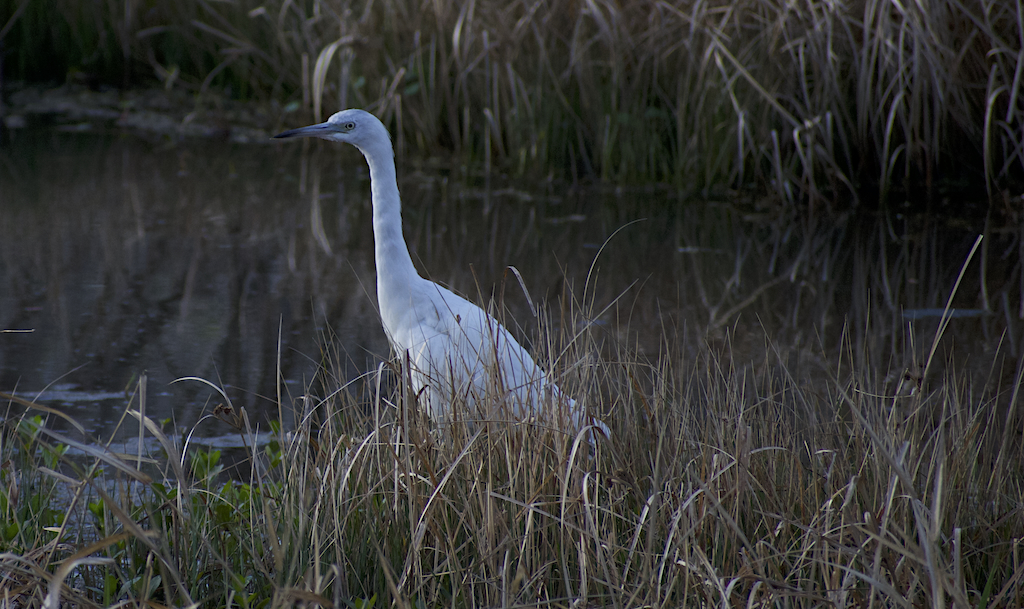
There’s something about the quality of morning light passing through pine trees that refuses to be rushed. It filters down in geometric patterns, constantly shifting, impossible to predict or recreate. I know this all to well since I’ve been chasing that light for decades now, camera in hand, breath held, waiting for the moment when a bird might pass through it.
Since 2003, this domain has sat mostly dormant—a nest built but rarely inhabited. Now, at 70, I find myself in a new home surrounded once again by woods, ponds, and the endless symphony of birdsong that has been the soundtrack of my life. Perhaps it’s time to finally fill this space with words, to complement the images I’ve been collecting all these years.
When I was a girl of nine or ten, my grandfather handed me a pair of heavy binoculars and pointed to a pair of silhouettes circling high above. “Hawks,” he said simply. “Watch.” I remember the weight of those binoculars more than anything, how they pulled my small neck backward as I struggled to find focus. When I finally did, the world changed. The hawks weren’t just birds—they were masters of the air, effortlessly riding thermals, their wings making subtle adjustments, almost as if they were writing messages across the sky.
“We don’t see things as they are,” Anaïs Nin once wrote, “we see them as we are.” I’ve thought about this often over my decades of bird photography—how my perception of a Great Blue Heron or a Kingfisher evolves as I age, how the images I capture today differ from those of my younger self, even when the subjects remain the same.
The writer Annie Dillard, whose work I return to like a familiar trail, observed that “how we spend our days is, of course, how we spend our lives.” By this accounting, I’ve spent much of my life in a peculiar state of suspended animation: motionless, waiting, watching. Hours dissolve in the quiet corners of wetlands and forests, time marked only by changes in light and the occasional whir of my camera’s shutter.
There is a monologue from that old TV show “Northern Exposure” where Chris Stevens talks about the “art of stillness”—about how true observation requires a kind of emptying of oneself. “Sometimes,” he says to his radio audience, “you have to be silent to hear the music of the spheres.” This has always resonated with me. The best photographs come when I’m least present, when I’ve disappeared into the landscape so completely that the birds forget I exist.
My new home sits at the edge of a small woodland area with two ponds. During my first week here, I spent each dawn sitting at the edge of the pond, cataloging sounds. Five different songbirds before sunrise. The distinct plop of frogs entering water. Wind through pine needles—a sound unlike wind through any other kind of tree. I was creating a sound map, orienting myself in this new wilderness.
It reminded me of something the composer John Luther Adams wrote about his time in Alaska: “For many years, I’ve been recording the songs of birds and the calls of animals… Through these experiences I’ve come to believe that music can serve as a way to engage more deeply with the world around us.” Photography has been this engagement for me—not just a way of seeing, but of connecting, of participating.
At seventy, I move more slowly through these landscapes. What was once an eight-hour hike with twenty pounds of equipment is now a gentle two-hour stroll with just my favorite lens. But there’s a quiet gift in this slowing: I see more. The Downy Woodpecker that I might have hurried past in my forties now receives my full attention. The common becomes extraordinary through the lens of patience.
Maria Popova writes that “critical thinking without hope is cynicism, but hope without critical thinking is naïveté.” I find myself thinking about this as I consider what this blog might become—a place where clear-eyed observation meets wonder, where the precise documentation of nature doesn’t diminish its mystery but somehow deepens it.
When the light is just right and the birds are active, I still feel the same rush I did at ten years old, looking through those heavy binoculars. Time compresses. The camera becomes weightless. In her book “Pilgrim at Tinker Creek,” Dillard describes seeing a cedar waxwing: “The waxwing whistled thin as a reed… I felt the head of a rabbit and the round eyes of a deer; my throat made a whining sound… I don’t know what it is I am doing or what this bird was up to. I suspect that this is the only way to see waxwings.“
Yesterday, a Belted Kingfisher landed on the dead pine that leans over my pond. I watched her for nearly an hour as she dove and emerged, dove and emerged, each time with a small flash of silver in her beak. In his poem “The Peace of Wild Things,” Wendell Berry writes: “When despair for the world grows in me… I come into the peace of wild things who do not tax their lives with forethought of grief.”
There is a peace in this watching, in this slowing down. There is a peace in finally giving voice to these decades of quiet observation. So here, finally, twenty two years after claiming this digital space, I begin, again. The nest is ready, and I have stories to tell.
“In the end,” writes Terry Tempest Williams, “I believe it is the small things that will save us. Small pieces of beauty quietly growing.”
Or perhaps, small birds, quietly going about their business while an old photographer watches from the shadows, still learning, still wondering, still following the light.